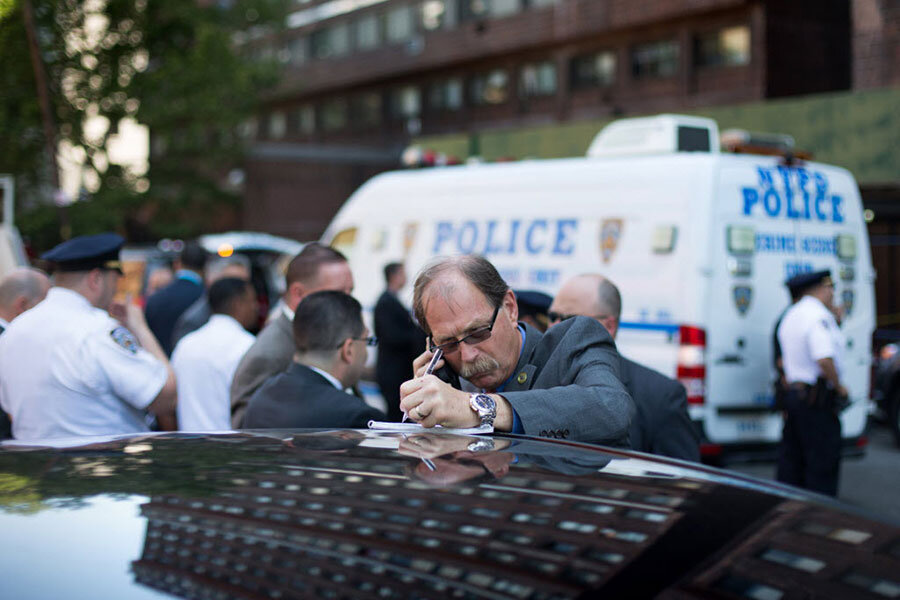Crime spike could throw police reform efforts into doubt
Loading...
| New York
A spike in crime in a number of American cities is giving momentum to the argument that more-liberal ideals of policing and law and order are leading to less-safe cities.
The intense scrutiny of police departments in the wake of events in Ferguson, Mo.; New York; Baltimore; North Charleston, S.C.; and elsewhere – where black men died in confrontations with police – has begun to rein in police behavior, and the result has been higher crime, some law enforcement officials say. Historic drops in crime came from aggressive policing, they add.
Criminologists are wary of jumping to such conclusions. Crime statistics often fluctuate, and it is too soon to draw any larger conclusions yet.
But whatever the reasons for the recent spikes, they could affect efforts to address the frayed relationship between police departments and minority communities nationwide.
Baltimore saw 42 murders in May, the highest monthly total since 1972. Homicides in Milwaukee spiked 180 percent from May last year. And in New York, homicides are already up 20 percent this year, and the number of shootings in the city has jumped two years in a row for the first time in more than 15 years.
The spike in New York could be particularly significant, given its status as a laboratory for liberal ideas under Mayor Bill de Blasio, who was elected on a platform that emphasized police reforms after the aggressive and controversial policies of his predecessors.
“Beyond the political and electoral repercussions for de Blasio, the key question both in N.Y.C. and beyond is the impact this has on progressive efforts to reform policing and police-community relations,” says Jeanne Zaino, a political scientist at Iona College in New Rochelle, N.Y.
“Even before de Blasio was elected there was concern that if he took office, he would institute policies that increased crime,” Professor Zaino adds. “And there was even quieter talk that a de Blasio-style progressive agenda wouldn't be possible if crime was high. The thinking was that he could only tackle these issues because crime had come down so far.”
In 2013, Mayor de Blasio railed against the aggressive stop and frisk practices of the New York Police Department, which gave police the authority to stop anyone they suspected of being involved in a crime. A federal judge that year said the practice violated the Constitution since more than 85 percent of such street stops were of minority young men. The practice has been dramatically curtailed. In addition, police have stopped arresting people for marijuana possession, issuing tickets instead, and the mayor has rejected a request by Commissioner Bill Bratton and the City Council for more police officers.
Law enforcement union officials say the crime spike is the result of these decisions.
“We have an anti-police culture that has spread across the country,” says Sgt. Ed Mullins, president of Sergeants Benevolent Association, one the New York Police Department’s police unions. “It’s not that the cops are backing down. They’re doing what our political leaders and public – the naysayers, the protesters – want. This is what they want. They want less-aggressive police.”
On Monday, the police union chairman in the District of Columbia echoed such sentiments after a violent weekend in the nation’s capital. “Since Ferguson, every single police encounter, particularly with someone who is a minority or someone who is black, is somehow deemed to be racism or discriminatory policing – and that is garbage,” Delroy Burton told the local Fox affiliate.
Whether the national climate after the events in Ferguson, New York, Baltimore, and other cities has contributed to the spikes in crime remains to be seen, experts say. They note that when crime is already at record lows, any rise can seen startling. But the statistics are are playing into long-held perceptions.
“[Liberals] have to overcome the stigma that traces back at least to Nixon, if not before, that conservatives do a better job maintaining law and order,” says Zaino of Iona College. Despite the fact that there are not yet clear correlations between the protests and the spikes in crime, “there’s always been kind of this low-simmering fear – a progressive agenda leads to an increase in crime.”
“And as one of the leading progressives in the country, this is really a huge task for de Blasio,” she says. “And I don't think he's accomplished it yet.”
For his part, Sergeant Mullins laments that the national discussion hasn’t emphasized what he believes is the primary issue in the tragic deaths of black men the past year: resisting arrest. And now police aren’t being allowed to do their jobs, he says.
“If I tell everybody today that the police aren’t going to lock up people who rob banks, how much money do you think is going to be in the bank at the end of the day?” he says. “And that’s what’s being created today,” he says of the increases in crime.
And politically, people will begin to realize this, Mullins says. “The pendulum has to swing back the other way for people to sit back and say, ‘I don’t want to be a victim. I want an aggressive police department,’ ” he says.








